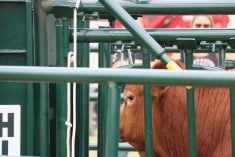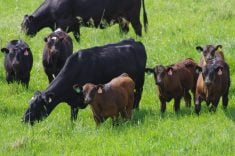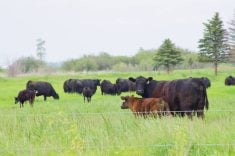The price of pasture land in Manitoba grew faster than anywhere else in the country last year, according to the latest farmland values report from Farm Credit Canada.
The report, posted in mid-March, said Manitoba’s pasture land values had increased 19 per cent through 2023, compared to 12.7 per cent in Saskatchewan and 9.6 per cent in Alberta. British Columbia was in fourth place with a 7.4 per cent increase.
Manitoba’s cattle country bore the brunt of those increases. In the Interlake, pasture land value increases far eclipsed the provincial average, growing 28.3 per cent. The Parkland saw similar growth at 27.4 per cent.
Read Also

Seeding Indigenous agricultural prosperity
National Circle for Indigenous Agriculture and Food says Indigenous agricultural success needs strong relationships.
Rates in other parts of the province grew more moderately. Western Manitoba saw increases of 6.4 per cent, FCC said. Land in that region was also more expensive to start with, and the lender noted that per acre pasture values in Westman were still higher than other areas.

It’s the second year that FCC has included pasture land in its annual report and, due to lack of information from eastern regions, data presented for 2023 covered only Western Canada.
Why it matters: The Bank of Canada has yet to lower interest rates but that hasn’t deterred farmland purchasers.
The lender pointed the finger at high demand for pasture, despite highly variable forage and pasture yields last year.
Drought held Western Canada in a chokehold last year, particularly in parts of Alberta and Saskatchewan, and at the end of December, the Canadian Drought Monitor classified all of the west, except the far northwest of B.C., as suffering some level of drought.
Large areas southeast of Calgary and into southwestern Saskatchewan were in extreme to exceptional drought, described by the monitor as a one-in-20 to one-in-50-year event.
Despite demand for pasture, Canada has fewer cattle than at any point in the last 35 years. In February, Statistics Canada reported that start-of-year cattle stocks were 11.1 million, 2.1 per cent lower than the year before and the smallest national cattle herd since 1989.
The agency attributed that to drought, record prices at auction marts and tight feed supplies. Farmers “responded by sending breeding stock to feedlots,” StatCan said.
In October 2023, FCC projected that the annual average price for a fed steer in Alberta would reach $225 per hundredweight, more than 45 per cent higher than the five-year average.
A troubling trend for beef producers
The cattle grazing pasture are worth more, but Manitoba Beef Producers general manager Carson Callum suggested demand for that land may have nothing to do with continued livestock production.
“A lot of these lands that have been purchased recently may have been bought as pasture land, but in many cases the intent is to chew them up for annual cropping,” said Callum. “That’s a big concern for us, since the cow-calf industry is so reliant on these pasture land habitats.”
Land typically considered only suitable for grazing now faces competition from emerging crop varieties developed for resilience, he noted. Producers may wonder whether cropping would be more profitable than pasture.

That said, cattle producers are riding a good market and grain prices have fallen.
“There’s been a bit of a downturn in some of the cash crop commodity prices, so there might not be as much of a desire to convert,” said Callum. “And we’ve seen an increase in cattle prices. So those market fundamentals will mean some of these lands will be maintained in place.”
There is also pressure for producers to embrace sustainable farming. The cattle sector has long argued that it’s operations, particularly at the cow-calf level, foster wildlife habitat and play a role in carbon sequestration and water management.
MBP’s lobby efforts echo that theme.
“If producers can get paid for the ecosystem services that they provide on pasture land habitat, like flood and drought mitigation or species at risk maintenance, that would be a good benefit for beef producers to keep (the land) in grass,” said Callum. “But again, when you can improve your bottom line by selling it for grain, I think you’re going to see that (switch) happen.”
Farmland’s growing price tag
The price of Canadian farmland in general continued its upward trend in 2023, FCC noted, but slowed compared to recent years. Average growth in the price of farmland was 11.5 per cent, down from 12.8 per cent in 2022.
“We had three consecutive years of … land values climbing. And so we’re seeing a little bit of a pullback,” said FCC chief economist J.P. Gervais. “It’s still double-digit, still a very significant increase.”
In Manitoba, there was a double-digit increase in farmland values at 11.1 per cent, just under the national average. Last year, the province posted an increase of 11.2 per cent and in 2021, that percentage was 9.9.
It was the third-highest year-over-year increase in the country. Only Saskatchewan (15.7 per cent) and Quebec (13.3 per cent) reported higher.
The report noted that limited supply coupled with strong demand drove the increases in value, despite high interest rates. Even if some potential purchasers were holding out for lower interest, FCC noted, tight supply resulted in quick sales of any land available and likely increased the price.
By region in Manitoba, the Interlake once again led the way, reporting an increase of 19 per cent. That’s significantly higher than in 2021 and 2022. FCC said there was strong demand and increased values throughout the region.
In western Manitoba, cropland values rose by 12.3 per cent, again based on strong demand and low supply. The region had the second-highest growth rate in the province, but, in a reversal from it’s pasture situation, had the second-lowest per-acre value in Manitoba. Areas with the biggest increases correlated with strong crop yields.

The Central Plains-Pembina Valley region retained its top spot for per-acre farmland values in 2023 and had an annual land value increase of 10.5 per cent, driven by strong demand as large operations continued to expand, FCC noted.
Variable rainfall in the Parkland region affected yields, but values still increased 7.9 per cent in 2023, compared to 7.5 per cent in 2022. Eastern Manitoba had the province’s lowest growth rate, where land values increased 6.7 per cent.
The price of irrigation
Strong demand for potatoes, often tied to irrigated land values, led to increased demand. Prices for irrigated land in the Westman and Central Plains-Pembina Valley areas increased 18.1 per cent, significantly higher than the 3.8 per cent posted the year before.
FCC said most sales of irrigated land were private deals between landlords and renters.
National trends
Demand for irrigated land was also the prime driver of values in Alberta, where value grew 11.7 per cent in 2023, the most of any of that province’s sectors. That pales in comparison to the 29.9 per cent increase reported in 2022. Those numbers weren’t a surprise for Gervais, given the heavy hammer of drought in Western Canada.
In 2021, drought spurred widespread government aid packages. In early 2022, big patches of southern, central and eastern Alberta, as well as most agricultural areas in Saskatchewan and Manitoba, were also in severe to exceptional drought, according to the Canadian drought monitor. Dryness continued through 2023.
Nationally, farmland value trends showed significant variability, Gervais noted. Growth in some provinces, such as Manitoba, remained above 10 per cent, while British Columbia’s pace dipped into the red by 3.1 per cent, although that province also had the highest average land value on a per-acre basis.

Rates from other provinces included 10.7 per cent in Ontario (down from 19.4 per cent in 2022), 7.8 per cent in Nova Scotia (down from 11.6), 7.4 per cent in Prince Edward Island (down from 18.7), 6.5 per cent in Alberta (down from 10 per cent) and 5.6 per cent (17.1 per cent in 2022) in New Brunswick.
Hard year for buyers
It was a generally unaffordable year to buy land, said Gervais, pointing to the double hit of high interest rates and flagging commodity prices. Actual farmland sales declined slightly from 2022 as producers exercised more caution around investment decisions.
He expects that caution to extend well into 2024 due to continued high interest rates, high input costs and lower grain prices.
In fact, he said farmland in many parts of the country is less affordable now than it’s ever been. Fiscal circumstances have also opened operations to more financial risk.
“It makes it more difficult for young farmers and young operations that have a desire to expand into the industry,” he said.
In the short term, farm receipts of grains, oilseeds and pulses are projected to decline by 13.2 per cent in 2024, in comparison to a 0.4 per cent increase in 2023. Gervais predicted a 4.8 per cent decline in 2024 earlier this year.
He urged producers to take action to manage these losses.
“An important part of preparing for inevitable, yet unpredictable, economic changes is not only creating a risk management plan, but also updating it as those shifts in the economy unfold,” he said.
















